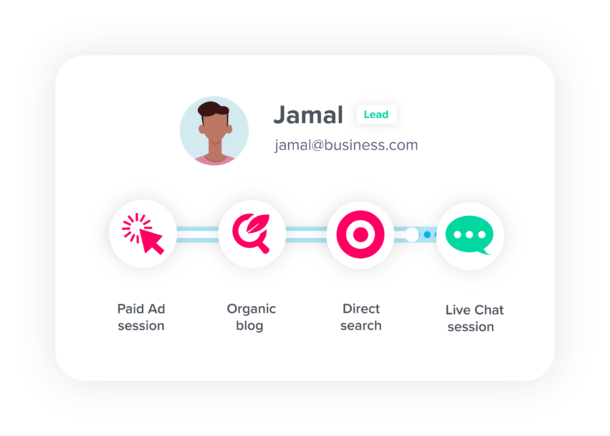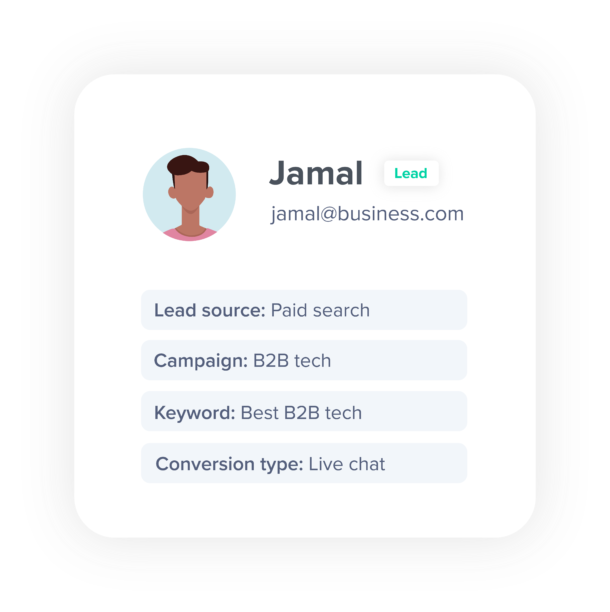Send marketing source data to the CRM and enrich your Google Analytics with web form, phone calls and live chat activity to understand which sources generate the most value.
According to research, 47% of companies struggle to gain insights from their marketing data due to data silos.
By integrating CRM data with Google Analytics, marketers can increase revenue by identifying the most profitable marketing channels and make informed decisions to drive more qualified leads and sales.
For this article, we’ll discuss:
💡 Pro Tip
Ruler makes it easy to track revenue in your Google Analytics. It sends marketing source data to your CRM and enriches your Google Analytics with closed revenue data, allowing you to track which marketing sources offer the greatest value.
How to automatically send marketing revenue in Google Analytics
Most often, B2B businesses will track marketing source and lead activity using Google Analytics and will store sales and customer success data within their customer relationship management system (CRM).
Google Analytics provides a wealth of data and allows you to understand where your leads are coming from and how visitors engage with your content.
By default, however, Google Analytics can’t tell you which marketing channels drive the most profitable sales.
In contrast, the CRM gives you a complete record of which leads are converting into high-value sales but lacks integrated visibility into which channels, campaigns and landing pages play the most significant role in the customer journey.
As a result, most marketing and sales funnels are disconnected. In fact, 1 in 4 companies say their sales and marketing teams are either “misaligned” or “rarely” aligned.

Marketers who lack visibility into the sales funnel will typically lean towards cost per lead metrics and goal completions in Google Analytics to track marketing effectiveness.
However, measuring and optimising your marketing activity based on lead volume can do more harm than good.
Consider this example:
Let’s say you set up an ad campaign on Facebook and Google to drive traffic to your website. After 30 days you weigh up the results, and find that Facebook has generated more traffic and leads than Google Ads.

Focusing on lead volume, Facebook Ads is the obvious top performer. However, that changes when we apply revenue data.

When we add monetary values, Google Ads had a greater impact on revenue activity, even though Facebook generated more leads and traffic.
Related: How to assign monetary values to conversions in Google Ads
Without complete visibility into the customer journey, there’s a good chance that you’re undervaluing the impact of your marketing and missing out on opportunities to increase conversion rates and sales volumes.
Most marketers know that they need to connect marketing activity with later stage funnel metrics but find it too difficult due to the following reasons:
The average sales cycle has increased 22% over the past five years due to more decision makers being involved in the buying process.
In addition to this, buyers are using more channels, online and offline, to engage with businesses and help make important purchasing decisions.
As a result, marketers are struggling to connect the dots and prove their impact on leads and sales.
💡 Pro Tip
Closed-loop attribution is a great way to connect your marketing and sales touchpoints. It automatically connects your closed revenue to your marketing channels, campaigns, keywords and more, allowing you to demonstrate your ROI more accurately.
Get started with closed-loop marketing attribution
More businesses are relying on automated data capture to collect key insights on leads and sales.
Google Analytics and the CRM have their unique purposes and capture data differently.
Analytics tracks anonymous website visits, clicks and goals.
The CRM, on the other hand, stores contact information, opportunity and revenue activity.
With differences in data capturing, marketers have had no choice but to make important budgetary decisions based on limited and unreliable insight.
Finding solutions online and then converting offline is increasingly common among B2B buyers.
When a lead or sale occurs offline, the data is generated and typically stored in the customer relationship management system, making it impossible for marketers to link campaign effectiveness directly to revenue.
To integrate your CRM with Google Analytics and track where your most valuable sales are coming from, you must first invest in a solution that can collect data about your visitors and automatically send lead generation activity to your CRM.
By connecting marketing lead source and conversion data, you can unlock valuable information in the CRM to provide sales and customer success teams with greater intelligence about where your leads came from.

Once a lead is won/closed, you can send CRM data to Google Analytics to gain end-to-end visibility of the customer journey and optimise performance based on revenue and not just goal completions.
Using a tool like Ruler, you can easily pass marketing source variables to your CRM across multiple touchpoints such as first/last click, landing page, keyword, GCLID, page views and sessions, allowing you to track your visitors’ multiple touchpoints to measure and attribute value accurately across the entire buyer’s journey.
Below is a step-by-step guide on how Ruler’s marketing attribution sends lead source data to your CRM and enriches your Google Analytics with web form, phone calls and live chat activity to gain end-to-end visibility of your sales process.
Ruler tracks each anonymous visitor to your website and measures any subsequent visits or interactions with other marketing channels, campaigns, keywords or landing pages.
Related: How to view full customer journeys with Ruler

If, or when, an anonymous visitor makes a conversion, whether it be a form fill, phone call or live chat, Ruler will update the data on that user to create a journey map for what is now known as a lead.

Next, the marketing and conversion data is sent to your CRM.
Marketing data includes channel, source, campaign, keyword and/or landing page.
Your sales team can now see what specific products, services, and/or features each lead was interested in while browsing your website.

Here is a list of triggers that you can push into your CRM using Ruler Analytics.
Available Ruler Analytics Triggers:
Available CRM Actions:
Whenever your lead converts into a sale, whether it be in a week, month or year, the value from the sale will get sent back to the Ruler dashboard so that you can measure the impact of your marketing sources, campaigns, keywords and ads based on monetary values and not just conversions.
Related: How to attribute revenue to your marketing with Ruler

You can send pipeline activity from your CRM back to the opportunity report in Ruler, allowing you to analyse the effectiveness of your campaigns at every stage of the buyer’s journey.
Learn more about opportunity attribution tracking and see how it can improve the quality of your reports.
Ruler Analytics utilises a pre-built integration to pass conversion and revenue data back to Google Analytics so that you track sales activity alongside all of your traditional metrics.
You can also report on revenue data for phone calls and live chat enquiries, allowing you to track the marketing sources that drive the most meaningful conversions and assign monetary values against offline activity.

Businesses that track their leads throughout the sales and marketing funnel can make informed decisions based on real revenue to reduce advertising costs and increase the number of qualified leads.
Integrating your CRM with Google Analytics for closed-loop reporting allows you to connect leads generated via web form, live chat or phone call directly back to the campaigns that generated them.
As a result, you can create and deliver marketing-generated ROI reports to clients and executives.
Want to know more about closed-loop reporting? Download the eBook on closed-loop marketing to learn more about the possibilities of Ruler. Alternatively, book a demo to speak with one of our sales representatives.
